Understanding the Role of Nurses in Addressing Vaccine Hesitancy in Children and Adolescents
VerifiedAdded on 2023/06/08
|8
|2432
|444
AI Summary
This article discusses the role of nurses in addressing vaccine hesitancy in children and adolescents. It provides information on the safety and effectiveness of vaccines, particularly the MMR vaccine, and strategies to promote effective communication with parents who have concerns about vaccination. The article emphasizes the importance of vaccination in preventing infectious diseases and the need for healthcare providers to build trust with parents to address vaccine concerns.
Contribute Materials
Your contribution can guide someone’s learning journey. Share your
documents today.
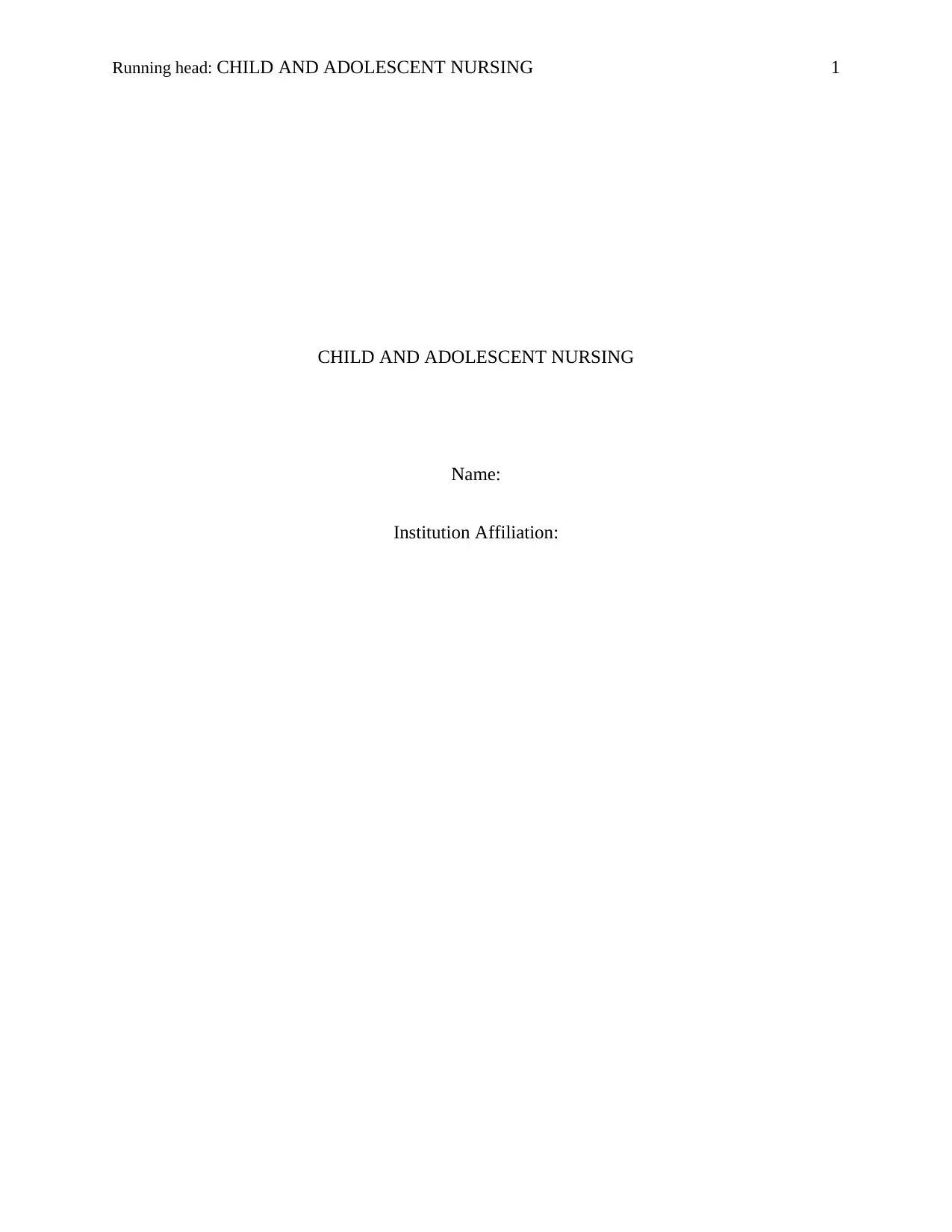
Running head: CHILD AND ADOLESCENT NURSING 1
CHILD AND ADOLESCENT NURSING
Name:
Institution Affiliation:
CHILD AND ADOLESCENT NURSING
Name:
Institution Affiliation:
Secure Best Marks with AI Grader
Need help grading? Try our AI Grader for instant feedback on your assignments.
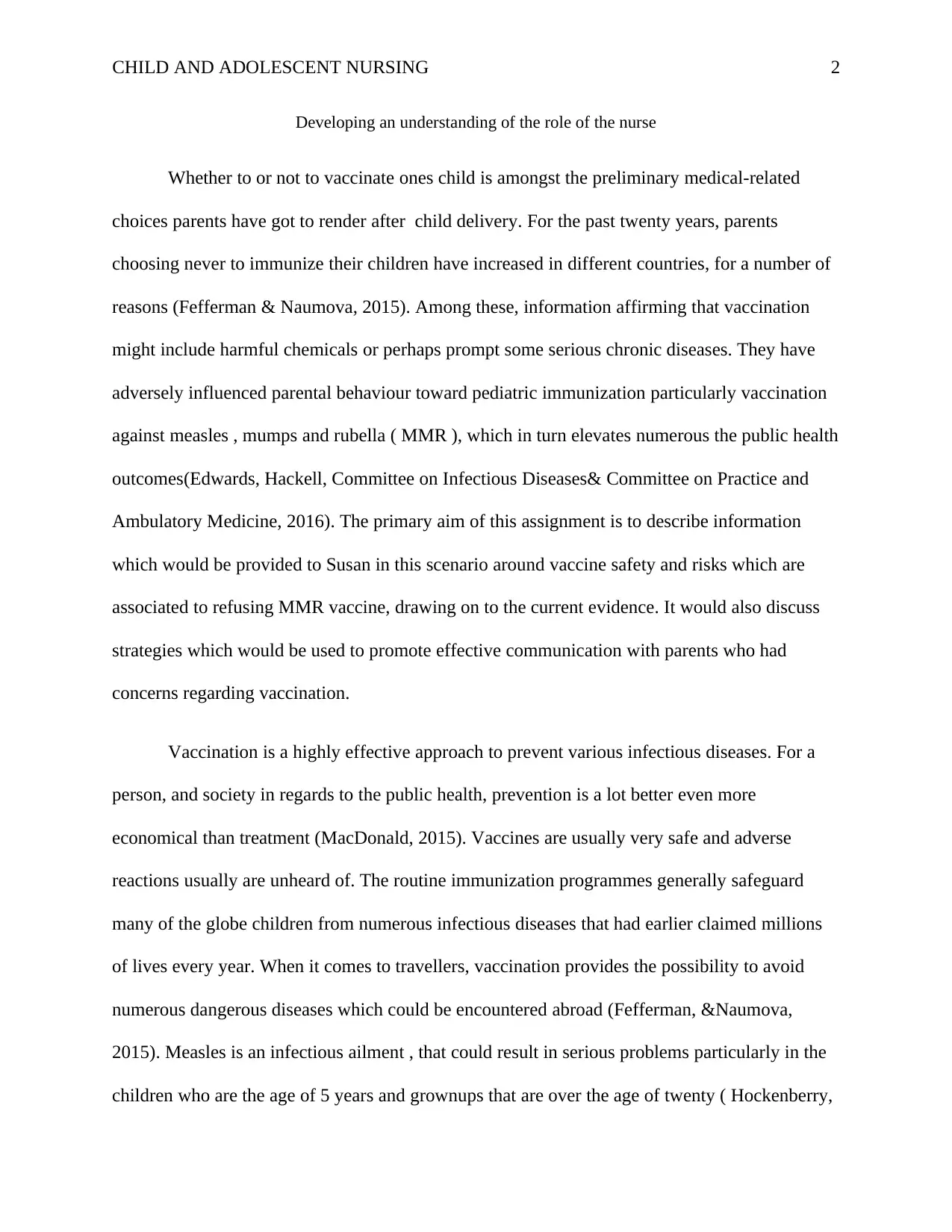
CHILD AND ADOLESCENT NURSING 2
Developing an understanding of the role of the nurse
Whether to or not to vaccinate ones child is amongst the preliminary medical-related
choices parents have got to render after child delivery. For the past twenty years, parents
choosing never to immunize their children have increased in different countries, for a number of
reasons (Fefferman & Naumova, 2015). Among these, information affirming that vaccination
might include harmful chemicals or perhaps prompt some serious chronic diseases. They have
adversely influenced parental behaviour toward pediatric immunization particularly vaccination
against measles , mumps and rubella ( MMR ), which in turn elevates numerous the public health
outcomes(Edwards, Hackell, Committee on Infectious Diseases& Committee on Practice and
Ambulatory Medicine, 2016). The primary aim of this assignment is to describe information
which would be provided to Susan in this scenario around vaccine safety and risks which are
associated to refusing MMR vaccine, drawing on to the current evidence. It would also discuss
strategies which would be used to promote effective communication with parents who had
concerns regarding vaccination.
Vaccination is a highly effective approach to prevent various infectious diseases. For a
person, and society in regards to the public health, prevention is a lot better even more
economical than treatment (MacDonald, 2015). Vaccines are usually very safe and adverse
reactions usually are unheard of. The routine immunization programmes generally safeguard
many of the globe children from numerous infectious diseases that had earlier claimed millions
of lives every year. When it comes to travellers, vaccination provides the possibility to avoid
numerous dangerous diseases which could be encountered abroad (Fefferman, &Naumova,
2015). Measles is an infectious ailment , that could result in serious problems particularly in the
children who are the age of 5 years and grownups that are over the age of twenty ( Hockenberry,
Developing an understanding of the role of the nurse
Whether to or not to vaccinate ones child is amongst the preliminary medical-related
choices parents have got to render after child delivery. For the past twenty years, parents
choosing never to immunize their children have increased in different countries, for a number of
reasons (Fefferman & Naumova, 2015). Among these, information affirming that vaccination
might include harmful chemicals or perhaps prompt some serious chronic diseases. They have
adversely influenced parental behaviour toward pediatric immunization particularly vaccination
against measles , mumps and rubella ( MMR ), which in turn elevates numerous the public health
outcomes(Edwards, Hackell, Committee on Infectious Diseases& Committee on Practice and
Ambulatory Medicine, 2016). The primary aim of this assignment is to describe information
which would be provided to Susan in this scenario around vaccine safety and risks which are
associated to refusing MMR vaccine, drawing on to the current evidence. It would also discuss
strategies which would be used to promote effective communication with parents who had
concerns regarding vaccination.
Vaccination is a highly effective approach to prevent various infectious diseases. For a
person, and society in regards to the public health, prevention is a lot better even more
economical than treatment (MacDonald, 2015). Vaccines are usually very safe and adverse
reactions usually are unheard of. The routine immunization programmes generally safeguard
many of the globe children from numerous infectious diseases that had earlier claimed millions
of lives every year. When it comes to travellers, vaccination provides the possibility to avoid
numerous dangerous diseases which could be encountered abroad (Fefferman, &Naumova,
2015). Measles is an infectious ailment , that could result in serious problems particularly in the
children who are the age of 5 years and grownups that are over the age of twenty ( Hockenberry,
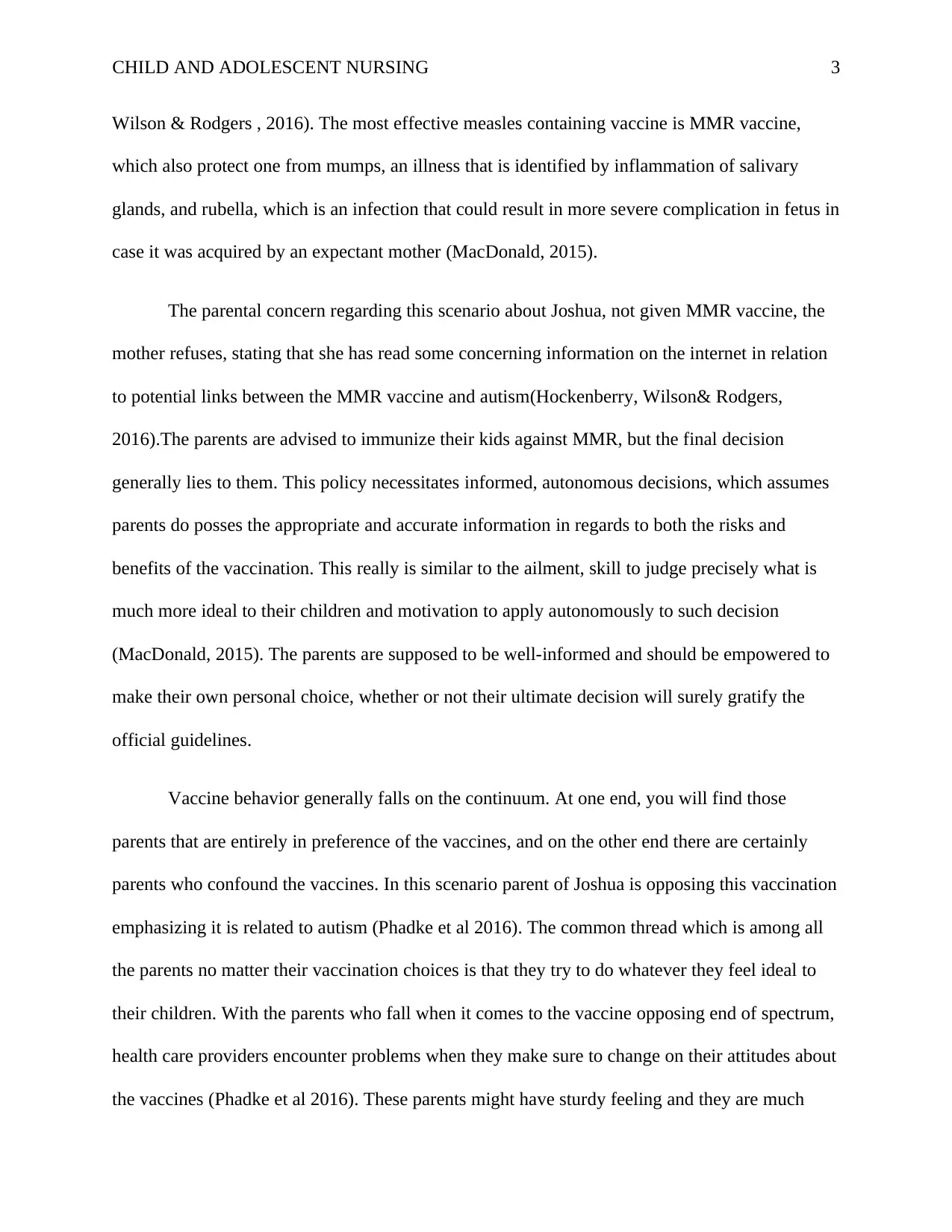
CHILD AND ADOLESCENT NURSING 3
Wilson & Rodgers , 2016). The most effective measles containing vaccine is MMR vaccine,
which also protect one from mumps, an illness that is identified by inflammation of salivary
glands, and rubella, which is an infection that could result in more severe complication in fetus in
case it was acquired by an expectant mother (MacDonald, 2015).
The parental concern regarding this scenario about Joshua, not given MMR vaccine, the
mother refuses, stating that she has read some concerning information on the internet in relation
to potential links between the MMR vaccine and autism(Hockenberry, Wilson& Rodgers,
2016).The parents are advised to immunize their kids against MMR, but the final decision
generally lies to them. This policy necessitates informed, autonomous decisions, which assumes
parents do posses the appropriate and accurate information in regards to both the risks and
benefits of the vaccination. This really is similar to the ailment, skill to judge precisely what is
much more ideal to their children and motivation to apply autonomously to such decision
(MacDonald, 2015). The parents are supposed to be well-informed and should be empowered to
make their own personal choice, whether or not their ultimate decision will surely gratify the
official guidelines.
Vaccine behavior generally falls on the continuum. At one end, you will find those
parents that are entirely in preference of the vaccines, and on the other end there are certainly
parents who confound the vaccines. In this scenario parent of Joshua is opposing this vaccination
emphasizing it is related to autism (Phadke et al 2016). The common thread which is among all
the parents no matter their vaccination choices is that they try to do whatever they feel ideal to
their children. With the parents who fall when it comes to the vaccine opposing end of spectrum,
health care providers encounter problems when they make sure to change on their attitudes about
the vaccines (Phadke et al 2016). These parents might have sturdy feeling and they are much
Wilson & Rodgers , 2016). The most effective measles containing vaccine is MMR vaccine,
which also protect one from mumps, an illness that is identified by inflammation of salivary
glands, and rubella, which is an infection that could result in more severe complication in fetus in
case it was acquired by an expectant mother (MacDonald, 2015).
The parental concern regarding this scenario about Joshua, not given MMR vaccine, the
mother refuses, stating that she has read some concerning information on the internet in relation
to potential links between the MMR vaccine and autism(Hockenberry, Wilson& Rodgers,
2016).The parents are advised to immunize their kids against MMR, but the final decision
generally lies to them. This policy necessitates informed, autonomous decisions, which assumes
parents do posses the appropriate and accurate information in regards to both the risks and
benefits of the vaccination. This really is similar to the ailment, skill to judge precisely what is
much more ideal to their children and motivation to apply autonomously to such decision
(MacDonald, 2015). The parents are supposed to be well-informed and should be empowered to
make their own personal choice, whether or not their ultimate decision will surely gratify the
official guidelines.
Vaccine behavior generally falls on the continuum. At one end, you will find those
parents that are entirely in preference of the vaccines, and on the other end there are certainly
parents who confound the vaccines. In this scenario parent of Joshua is opposing this vaccination
emphasizing it is related to autism (Phadke et al 2016). The common thread which is among all
the parents no matter their vaccination choices is that they try to do whatever they feel ideal to
their children. With the parents who fall when it comes to the vaccine opposing end of spectrum,
health care providers encounter problems when they make sure to change on their attitudes about
the vaccines (Phadke et al 2016). These parents might have sturdy feeling and they are much
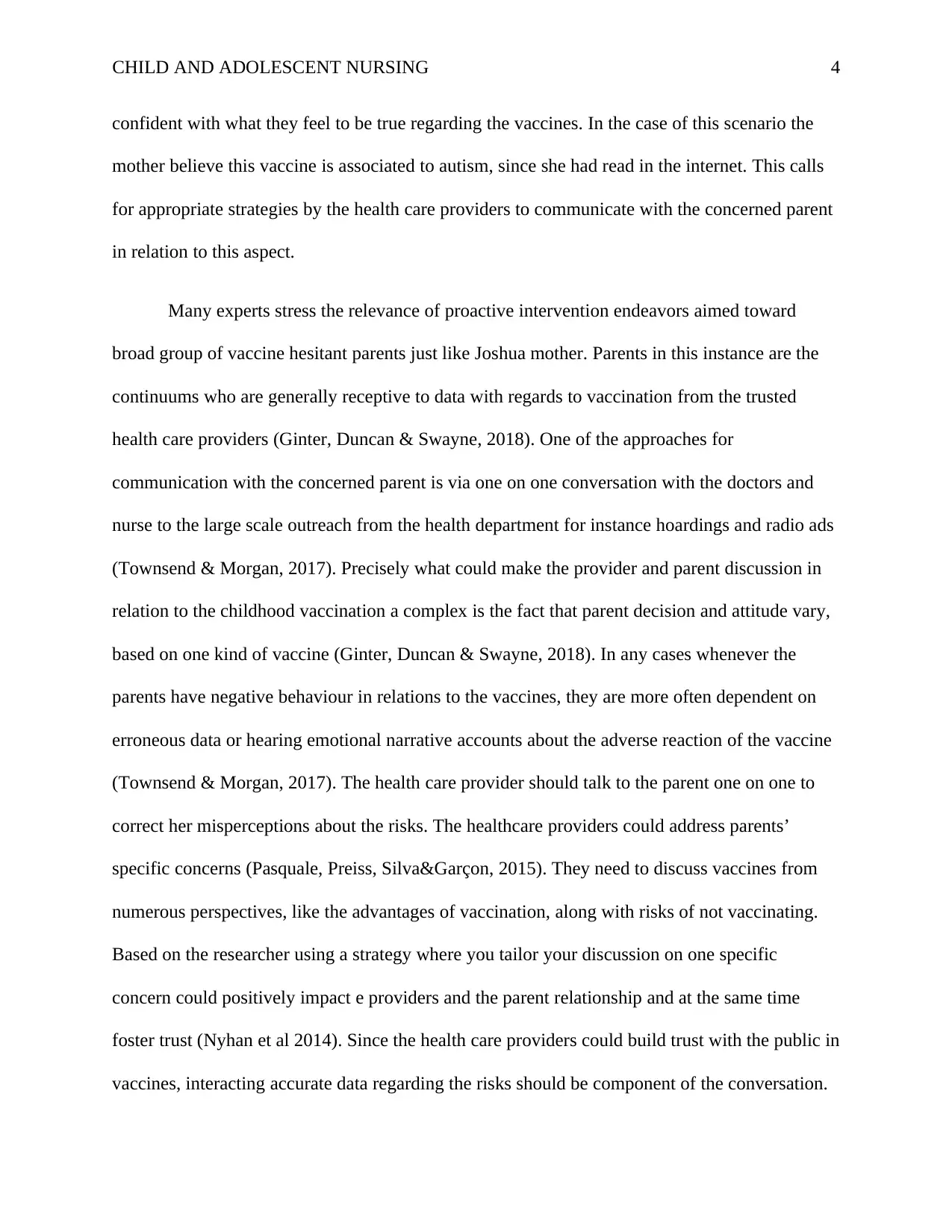
CHILD AND ADOLESCENT NURSING 4
confident with what they feel to be true regarding the vaccines. In the case of this scenario the
mother believe this vaccine is associated to autism, since she had read in the internet. This calls
for appropriate strategies by the health care providers to communicate with the concerned parent
in relation to this aspect.
Many experts stress the relevance of proactive intervention endeavors aimed toward
broad group of vaccine hesitant parents just like Joshua mother. Parents in this instance are the
continuums who are generally receptive to data with regards to vaccination from the trusted
health care providers (Ginter, Duncan & Swayne, 2018). One of the approaches for
communication with the concerned parent is via one on one conversation with the doctors and
nurse to the large scale outreach from the health department for instance hoardings and radio ads
(Townsend & Morgan, 2017). Precisely what could make the provider and parent discussion in
relation to the childhood vaccination a complex is the fact that parent decision and attitude vary,
based on one kind of vaccine (Ginter, Duncan & Swayne, 2018). In any cases whenever the
parents have negative behaviour in relations to the vaccines, they are more often dependent on
erroneous data or hearing emotional narrative accounts about the adverse reaction of the vaccine
(Townsend & Morgan, 2017). The health care provider should talk to the parent one on one to
correct her misperceptions about the risks. The healthcare providers could address parents’
specific concerns (Pasquale, Preiss, Silva&Garçon, 2015). They need to discuss vaccines from
numerous perspectives, like the advantages of vaccination, along with risks of not vaccinating.
Based on the researcher using a strategy where you tailor your discussion on one specific
concern could positively impact e providers and the parent relationship and at the same time
foster trust (Nyhan et al 2014). Since the health care providers could build trust with the public in
vaccines, interacting accurate data regarding the risks should be component of the conversation.
confident with what they feel to be true regarding the vaccines. In the case of this scenario the
mother believe this vaccine is associated to autism, since she had read in the internet. This calls
for appropriate strategies by the health care providers to communicate with the concerned parent
in relation to this aspect.
Many experts stress the relevance of proactive intervention endeavors aimed toward
broad group of vaccine hesitant parents just like Joshua mother. Parents in this instance are the
continuums who are generally receptive to data with regards to vaccination from the trusted
health care providers (Ginter, Duncan & Swayne, 2018). One of the approaches for
communication with the concerned parent is via one on one conversation with the doctors and
nurse to the large scale outreach from the health department for instance hoardings and radio ads
(Townsend & Morgan, 2017). Precisely what could make the provider and parent discussion in
relation to the childhood vaccination a complex is the fact that parent decision and attitude vary,
based on one kind of vaccine (Ginter, Duncan & Swayne, 2018). In any cases whenever the
parents have negative behaviour in relations to the vaccines, they are more often dependent on
erroneous data or hearing emotional narrative accounts about the adverse reaction of the vaccine
(Townsend & Morgan, 2017). The health care provider should talk to the parent one on one to
correct her misperceptions about the risks. The healthcare providers could address parents’
specific concerns (Pasquale, Preiss, Silva&Garçon, 2015). They need to discuss vaccines from
numerous perspectives, like the advantages of vaccination, along with risks of not vaccinating.
Based on the researcher using a strategy where you tailor your discussion on one specific
concern could positively impact e providers and the parent relationship and at the same time
foster trust (Nyhan et al 2014). Since the health care providers could build trust with the public in
vaccines, interacting accurate data regarding the risks should be component of the conversation.
Secure Best Marks with AI Grader
Need help grading? Try our AI Grader for instant feedback on your assignments.
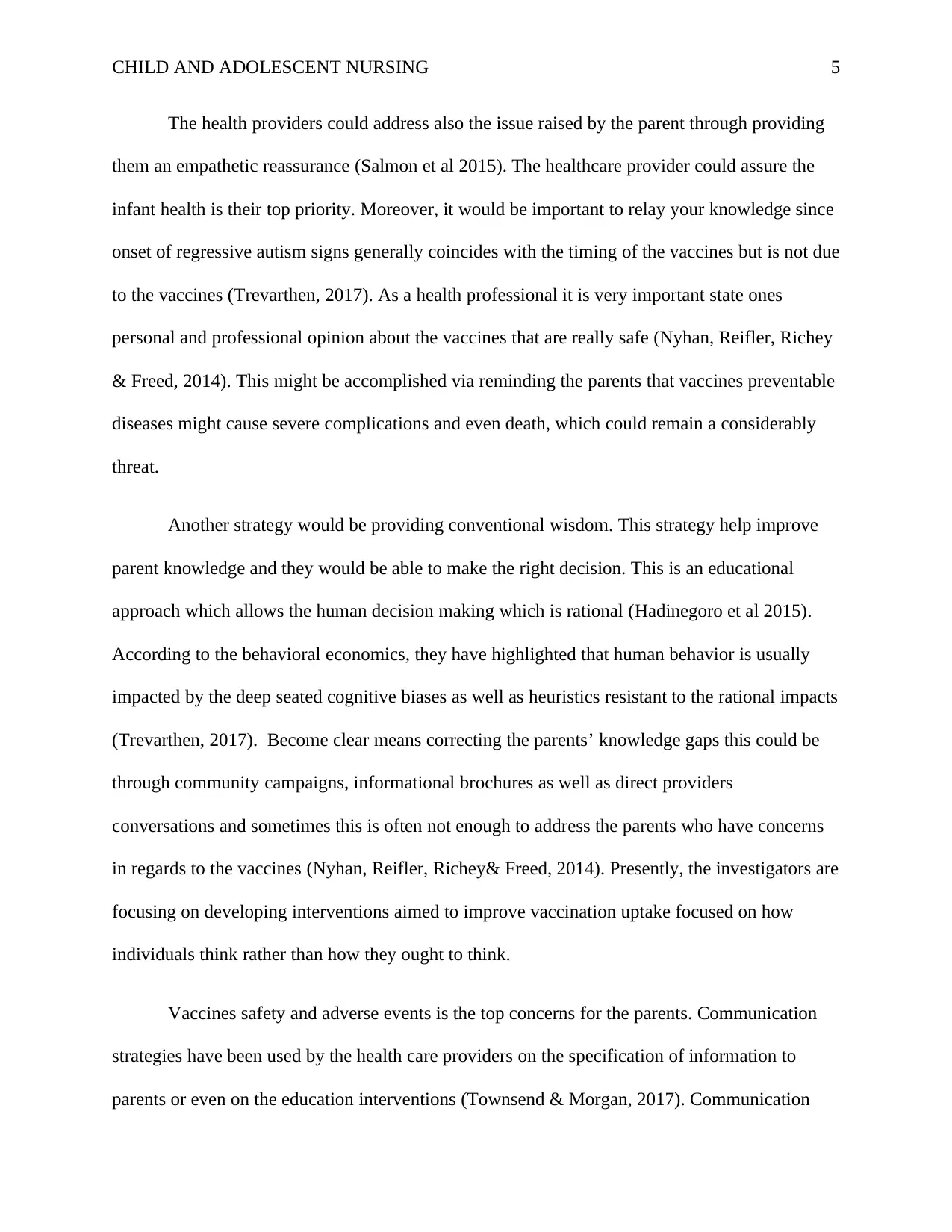
CHILD AND ADOLESCENT NURSING 5
The health providers could address also the issue raised by the parent through providing
them an empathetic reassurance (Salmon et al 2015). The healthcare provider could assure the
infant health is their top priority. Moreover, it would be important to relay your knowledge since
onset of regressive autism signs generally coincides with the timing of the vaccines but is not due
to the vaccines (Trevarthen, 2017). As a health professional it is very important state ones
personal and professional opinion about the vaccines that are really safe (Nyhan, Reifler, Richey
& Freed, 2014). This might be accomplished via reminding the parents that vaccines preventable
diseases might cause severe complications and even death, which could remain a considerably
threat.
Another strategy would be providing conventional wisdom. This strategy help improve
parent knowledge and they would be able to make the right decision. This is an educational
approach which allows the human decision making which is rational (Hadinegoro et al 2015).
According to the behavioral economics, they have highlighted that human behavior is usually
impacted by the deep seated cognitive biases as well as heuristics resistant to the rational impacts
(Trevarthen, 2017). Become clear means correcting the parents’ knowledge gaps this could be
through community campaigns, informational brochures as well as direct providers
conversations and sometimes this is often not enough to address the parents who have concerns
in regards to the vaccines (Nyhan, Reifler, Richey& Freed, 2014). Presently, the investigators are
focusing on developing interventions aimed to improve vaccination uptake focused on how
individuals think rather than how they ought to think.
Vaccines safety and adverse events is the top concerns for the parents. Communication
strategies have been used by the health care providers on the specification of information to
parents or even on the education interventions (Townsend & Morgan, 2017). Communication
The health providers could address also the issue raised by the parent through providing
them an empathetic reassurance (Salmon et al 2015). The healthcare provider could assure the
infant health is their top priority. Moreover, it would be important to relay your knowledge since
onset of regressive autism signs generally coincides with the timing of the vaccines but is not due
to the vaccines (Trevarthen, 2017). As a health professional it is very important state ones
personal and professional opinion about the vaccines that are really safe (Nyhan, Reifler, Richey
& Freed, 2014). This might be accomplished via reminding the parents that vaccines preventable
diseases might cause severe complications and even death, which could remain a considerably
threat.
Another strategy would be providing conventional wisdom. This strategy help improve
parent knowledge and they would be able to make the right decision. This is an educational
approach which allows the human decision making which is rational (Hadinegoro et al 2015).
According to the behavioral economics, they have highlighted that human behavior is usually
impacted by the deep seated cognitive biases as well as heuristics resistant to the rational impacts
(Trevarthen, 2017). Become clear means correcting the parents’ knowledge gaps this could be
through community campaigns, informational brochures as well as direct providers
conversations and sometimes this is often not enough to address the parents who have concerns
in regards to the vaccines (Nyhan, Reifler, Richey& Freed, 2014). Presently, the investigators are
focusing on developing interventions aimed to improve vaccination uptake focused on how
individuals think rather than how they ought to think.
Vaccines safety and adverse events is the top concerns for the parents. Communication
strategies have been used by the health care providers on the specification of information to
parents or even on the education interventions (Townsend & Morgan, 2017). Communication
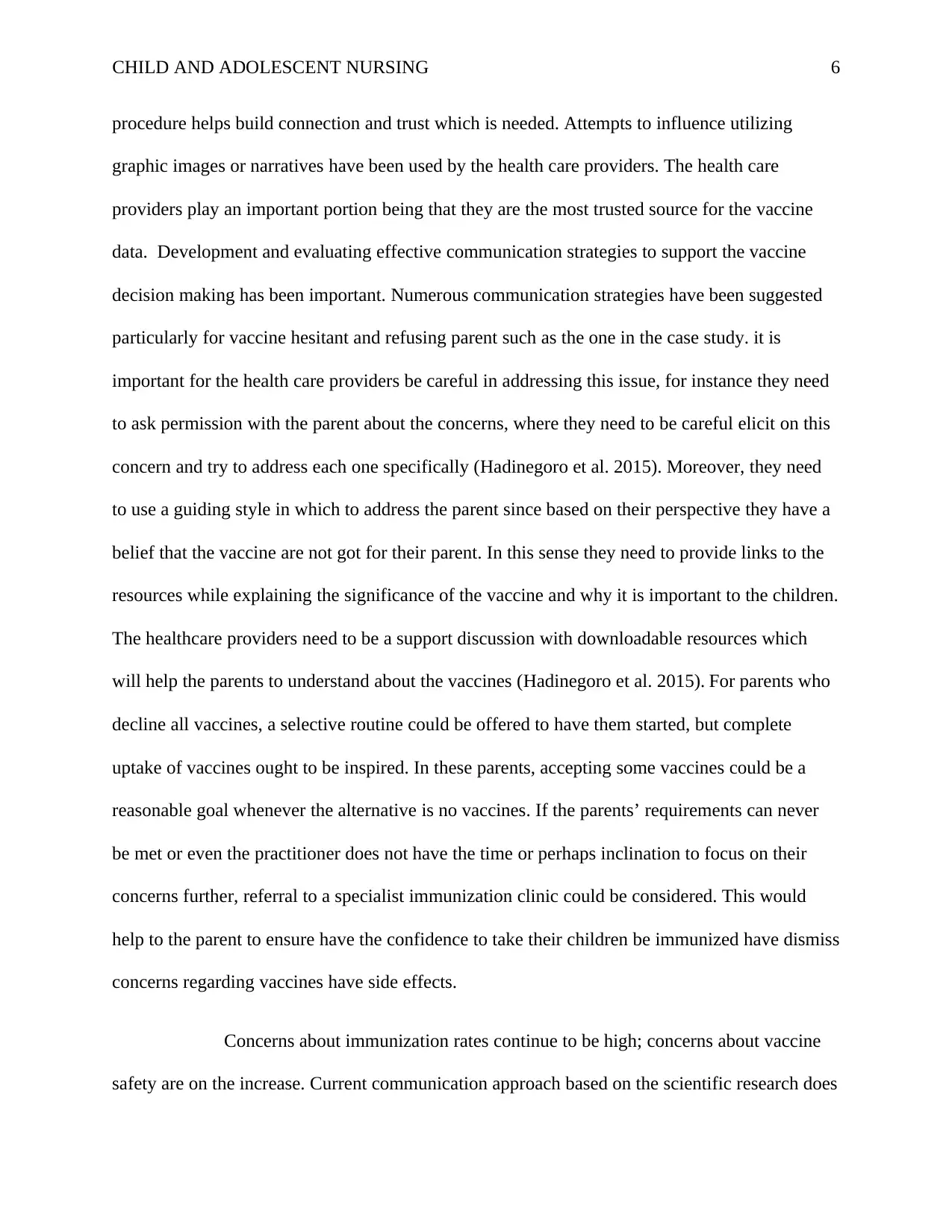
CHILD AND ADOLESCENT NURSING 6
procedure helps build connection and trust which is needed. Attempts to influence utilizing
graphic images or narratives have been used by the health care providers. The health care
providers play an important portion being that they are the most trusted source for the vaccine
data. Development and evaluating effective communication strategies to support the vaccine
decision making has been important. Numerous communication strategies have been suggested
particularly for vaccine hesitant and refusing parent such as the one in the case study. it is
important for the health care providers be careful in addressing this issue, for instance they need
to ask permission with the parent about the concerns, where they need to be careful elicit on this
concern and try to address each one specifically (Hadinegoro et al. 2015). Moreover, they need
to use a guiding style in which to address the parent since based on their perspective they have a
belief that the vaccine are not got for their parent. In this sense they need to provide links to the
resources while explaining the significance of the vaccine and why it is important to the children.
The healthcare providers need to be a support discussion with downloadable resources which
will help the parents to understand about the vaccines (Hadinegoro et al. 2015). For parents who
decline all vaccines, a selective routine could be offered to have them started, but complete
uptake of vaccines ought to be inspired. In these parents, accepting some vaccines could be a
reasonable goal whenever the alternative is no vaccines. If the parents’ requirements can never
be met or even the practitioner does not have the time or perhaps inclination to focus on their
concerns further, referral to a specialist immunization clinic could be considered. This would
help to the parent to ensure have the confidence to take their children be immunized have dismiss
concerns regarding vaccines have side effects.
Concerns about immunization rates continue to be high; concerns about vaccine
safety are on the increase. Current communication approach based on the scientific research does
procedure helps build connection and trust which is needed. Attempts to influence utilizing
graphic images or narratives have been used by the health care providers. The health care
providers play an important portion being that they are the most trusted source for the vaccine
data. Development and evaluating effective communication strategies to support the vaccine
decision making has been important. Numerous communication strategies have been suggested
particularly for vaccine hesitant and refusing parent such as the one in the case study. it is
important for the health care providers be careful in addressing this issue, for instance they need
to ask permission with the parent about the concerns, where they need to be careful elicit on this
concern and try to address each one specifically (Hadinegoro et al. 2015). Moreover, they need
to use a guiding style in which to address the parent since based on their perspective they have a
belief that the vaccine are not got for their parent. In this sense they need to provide links to the
resources while explaining the significance of the vaccine and why it is important to the children.
The healthcare providers need to be a support discussion with downloadable resources which
will help the parents to understand about the vaccines (Hadinegoro et al. 2015). For parents who
decline all vaccines, a selective routine could be offered to have them started, but complete
uptake of vaccines ought to be inspired. In these parents, accepting some vaccines could be a
reasonable goal whenever the alternative is no vaccines. If the parents’ requirements can never
be met or even the practitioner does not have the time or perhaps inclination to focus on their
concerns further, referral to a specialist immunization clinic could be considered. This would
help to the parent to ensure have the confidence to take their children be immunized have dismiss
concerns regarding vaccines have side effects.
Concerns about immunization rates continue to be high; concerns about vaccine
safety are on the increase. Current communication approach based on the scientific research does
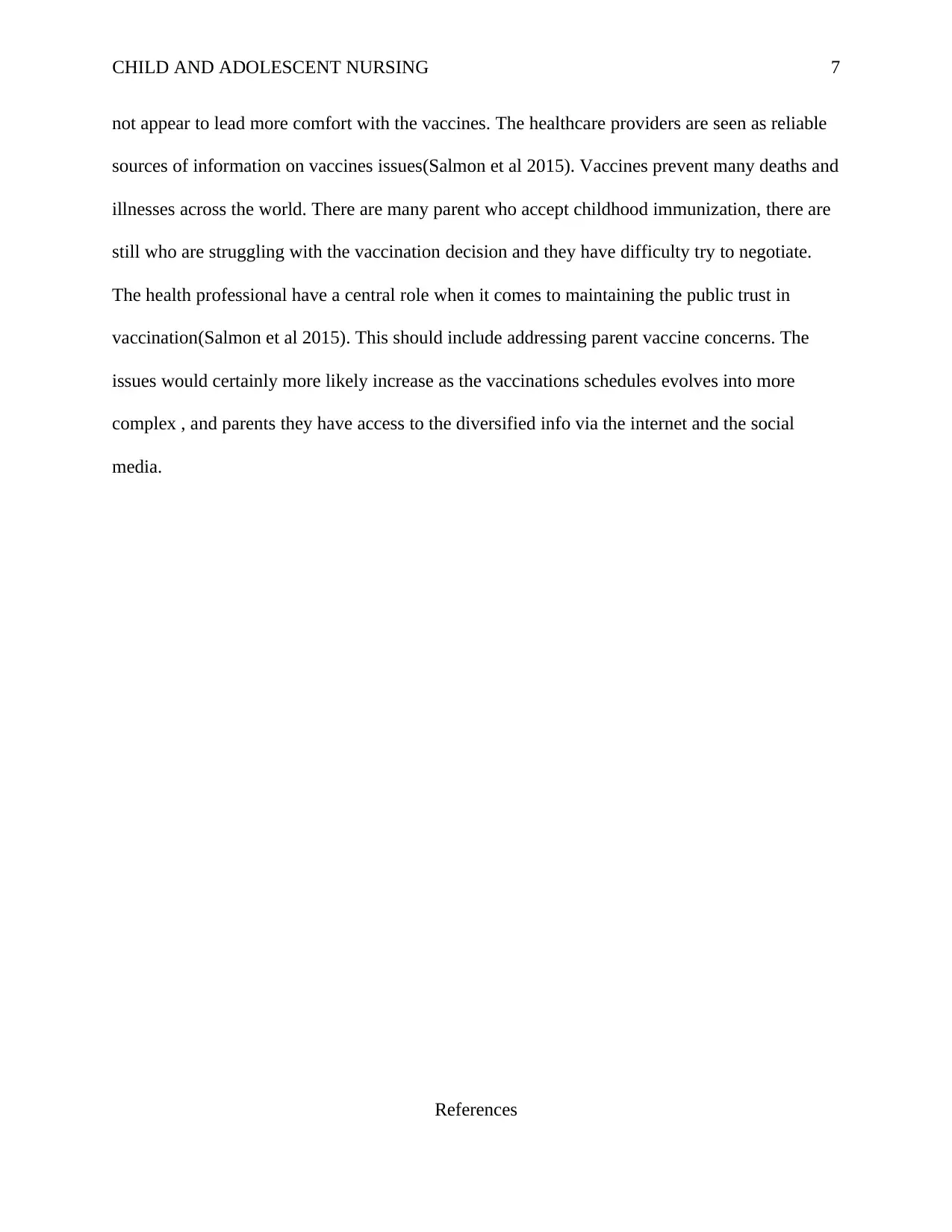
CHILD AND ADOLESCENT NURSING 7
not appear to lead more comfort with the vaccines. The healthcare providers are seen as reliable
sources of information on vaccines issues(Salmon et al 2015). Vaccines prevent many deaths and
illnesses across the world. There are many parent who accept childhood immunization, there are
still who are struggling with the vaccination decision and they have difficulty try to negotiate.
The health professional have a central role when it comes to maintaining the public trust in
vaccination(Salmon et al 2015). This should include addressing parent vaccine concerns. The
issues would certainly more likely increase as the vaccinations schedules evolves into more
complex , and parents they have access to the diversified info via the internet and the social
media.
References
not appear to lead more comfort with the vaccines. The healthcare providers are seen as reliable
sources of information on vaccines issues(Salmon et al 2015). Vaccines prevent many deaths and
illnesses across the world. There are many parent who accept childhood immunization, there are
still who are struggling with the vaccination decision and they have difficulty try to negotiate.
The health professional have a central role when it comes to maintaining the public trust in
vaccination(Salmon et al 2015). This should include addressing parent vaccine concerns. The
issues would certainly more likely increase as the vaccinations schedules evolves into more
complex , and parents they have access to the diversified info via the internet and the social
media.
References
Paraphrase This Document
Need a fresh take? Get an instant paraphrase of this document with our AI Paraphraser
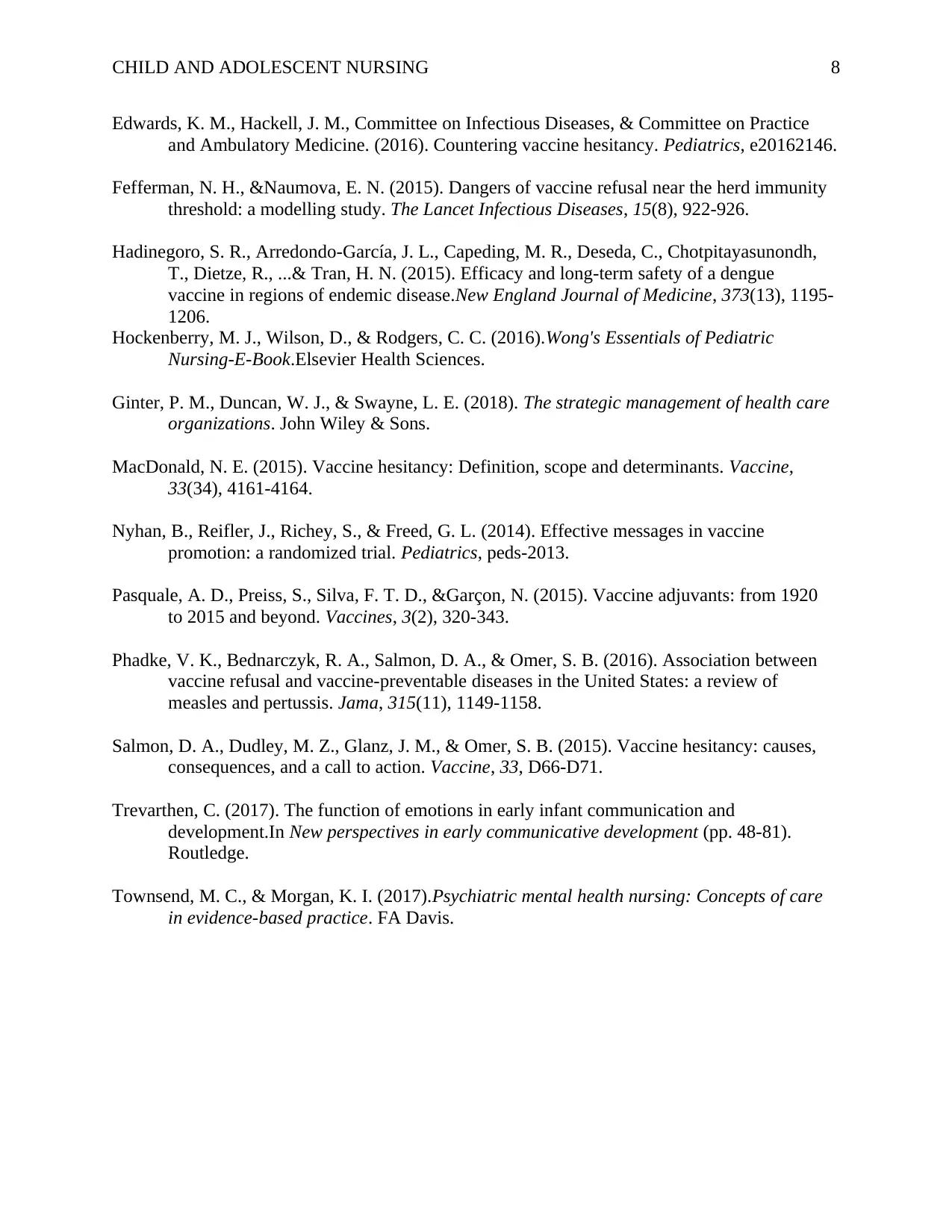
CHILD AND ADOLESCENT NURSING 8
Edwards, K. M., Hackell, J. M., Committee on Infectious Diseases, & Committee on Practice
and Ambulatory Medicine. (2016). Countering vaccine hesitancy. Pediatrics, e20162146.
Fefferman, N. H., &Naumova, E. N. (2015). Dangers of vaccine refusal near the herd immunity
threshold: a modelling study. The Lancet Infectious Diseases, 15(8), 922-926.
Hadinegoro, S. R., Arredondo-García, J. L., Capeding, M. R., Deseda, C., Chotpitayasunondh,
T., Dietze, R., ...& Tran, H. N. (2015). Efficacy and long-term safety of a dengue
vaccine in regions of endemic disease.New England Journal of Medicine, 373(13), 1195-
1206.
Hockenberry, M. J., Wilson, D., & Rodgers, C. C. (2016).Wong's Essentials of Pediatric
Nursing-E-Book.Elsevier Health Sciences.
Ginter, P. M., Duncan, W. J., & Swayne, L. E. (2018). The strategic management of health care
organizations. John Wiley & Sons.
MacDonald, N. E. (2015). Vaccine hesitancy: Definition, scope and determinants. Vaccine,
33(34), 4161-4164.
Nyhan, B., Reifler, J., Richey, S., & Freed, G. L. (2014). Effective messages in vaccine
promotion: a randomized trial. Pediatrics, peds-2013.
Pasquale, A. D., Preiss, S., Silva, F. T. D., &Garçon, N. (2015). Vaccine adjuvants: from 1920
to 2015 and beyond. Vaccines, 3(2), 320-343.
Phadke, V. K., Bednarczyk, R. A., Salmon, D. A., & Omer, S. B. (2016). Association between
vaccine refusal and vaccine-preventable diseases in the United States: a review of
measles and pertussis. Jama, 315(11), 1149-1158.
Salmon, D. A., Dudley, M. Z., Glanz, J. M., & Omer, S. B. (2015). Vaccine hesitancy: causes,
consequences, and a call to action. Vaccine, 33, D66-D71.
Trevarthen, C. (2017). The function of emotions in early infant communication and
development.In New perspectives in early communicative development (pp. 48-81).
Routledge.
Townsend, M. C., & Morgan, K. I. (2017).Psychiatric mental health nursing: Concepts of care
in evidence-based practice. FA Davis.
Edwards, K. M., Hackell, J. M., Committee on Infectious Diseases, & Committee on Practice
and Ambulatory Medicine. (2016). Countering vaccine hesitancy. Pediatrics, e20162146.
Fefferman, N. H., &Naumova, E. N. (2015). Dangers of vaccine refusal near the herd immunity
threshold: a modelling study. The Lancet Infectious Diseases, 15(8), 922-926.
Hadinegoro, S. R., Arredondo-García, J. L., Capeding, M. R., Deseda, C., Chotpitayasunondh,
T., Dietze, R., ...& Tran, H. N. (2015). Efficacy and long-term safety of a dengue
vaccine in regions of endemic disease.New England Journal of Medicine, 373(13), 1195-
1206.
Hockenberry, M. J., Wilson, D., & Rodgers, C. C. (2016).Wong's Essentials of Pediatric
Nursing-E-Book.Elsevier Health Sciences.
Ginter, P. M., Duncan, W. J., & Swayne, L. E. (2018). The strategic management of health care
organizations. John Wiley & Sons.
MacDonald, N. E. (2015). Vaccine hesitancy: Definition, scope and determinants. Vaccine,
33(34), 4161-4164.
Nyhan, B., Reifler, J., Richey, S., & Freed, G. L. (2014). Effective messages in vaccine
promotion: a randomized trial. Pediatrics, peds-2013.
Pasquale, A. D., Preiss, S., Silva, F. T. D., &Garçon, N. (2015). Vaccine adjuvants: from 1920
to 2015 and beyond. Vaccines, 3(2), 320-343.
Phadke, V. K., Bednarczyk, R. A., Salmon, D. A., & Omer, S. B. (2016). Association between
vaccine refusal and vaccine-preventable diseases in the United States: a review of
measles and pertussis. Jama, 315(11), 1149-1158.
Salmon, D. A., Dudley, M. Z., Glanz, J. M., & Omer, S. B. (2015). Vaccine hesitancy: causes,
consequences, and a call to action. Vaccine, 33, D66-D71.
Trevarthen, C. (2017). The function of emotions in early infant communication and
development.In New perspectives in early communicative development (pp. 48-81).
Routledge.
Townsend, M. C., & Morgan, K. I. (2017).Psychiatric mental health nursing: Concepts of care
in evidence-based practice. FA Davis.
1 out of 8
Related Documents
Your All-in-One AI-Powered Toolkit for Academic Success.
+13062052269
info@desklib.com
Available 24*7 on WhatsApp / Email
![[object Object]](/_next/static/media/star-bottom.7253800d.svg)
Unlock your academic potential
© 2024 | Zucol Services PVT LTD | All rights reserved.





